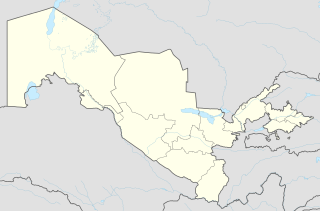 W
WAkchakhan-Kala, or Akcha-khan Kala, also named after the locality Kazakly-Yatkan/ Kazakl'i-Yatkan, in modern Karakalpakstan, Uzbekistan, was an ancient fortress in Chorasmia built in the 4th/ 3rd century BCE and occupied until it was despoiled in the 2nd century CE. It is part of the "Fifty fortresses oasis" in modern-day Uzbekistan. The abandonment of Akchakhan-Kala was apparently followed by the establishment of the new capital of Toprak-Kala, 14 km to the northeast.
 W
WAyaz-Kala is an archaeological site in Northern Uzbekistan, built between the 4th century BCE and the 7th century CE. Situated on a hilltop overlooking the Kyzylkum Desert, the site encompasses the ruins of an ancient Khorezm fortress.
 W
WDalverzin Tepe is an ancient archaeological site located in the northern part of the region of Bactria, southern modern Uzbekistan, about 120 km north-east of Termez.
 W
WGuldursun-Kala, also Guldursun Qala, in modern Karakalpakstan, Uzbekistan, was an ancient fortress in Chorasmia built in the 12th century CE. It is one of the largest fortresses of Khwarezm, with perimeter walls of about 1 kilometer in total length, and an internal area of about 6.4 hectares.
 W
WKantubek is a ghost town on Vozrozhdeniya Island in the Aral Sea. The town is still found on maps but was abandoned in 1992 following the dissolution of the Soviet Union. It is currently uninhabited and lying in ruins. Kantubek used to have a population of approximately 1,500 and housed scientists and employees of the Soviet Union's top-secret Aralsk-7 biological weapons research and test site.
 W
WKoi Krylgan Kala is an archaeological site located outside the village of Taza-Kel'timinar in the Ellikqal'a District in the Republic of Karakalpakstan, an autonomous republic of Uzbekistan. In ancient times, it was sited along a canal in the Oxus delta region.
 W
WKyzyl-Kala, also Qyzyl Qala, in modern Karakalpakstan, Uzbekistan, was an ancient fortress in Chorasmia built in the 1st-4th century CE. The small fortress of Kyzyl-Kala is located near Toprak-Kala, about 1 km to the west, and was also built in the 1st-4th century CE, possibly as a fortified defense for the site of Toprak-Kala. Kyzyl-Kala was once restored in the 12th century CE. It has also been the subject of a modern renovation program, with the objective of showing what a fortress looked like originally. It is part of the "Fifty fortresses oasis" in modern-day Uzbekistan. It was last occupied by Muhammad II of Khwarazm, before it fell to the Mongol conquest of the Khwarazmian Empire.
 W
WRabinjan or Arbinjan was a medieval town in the region of Transoxiana, between the cities of Samarkand and Bukhara. It was located in the vicinity of the present-day Katta-Kurgan.
 W
WTavka Kurgan is an ancient fortress and archaeological site near Shirabad, Uzbekistan. It is especially famous for some frescoes dated to the 5th-6th century CE, several of them located in the Archaeological Museum of Termez. One of these paintings, the so-called "Princess of Tokharistan", is actually thought to represent a hunter.
 W
WToprak-Kala, in modern Karakalpakstan, Uzbekistan, was an ancient palace city and the capital of in Chorasmia in the 2nd/3rd century CE, where wall paintings, coins and archives were discovered. Its history covers a period from the 1st to the 5th century CE. It is part of the "Fifty fortresses oasis" in modern-day Uzbekistan.
 W
WVarakhsha, also Varasha or Varahsha, was an ancient city in the Bukhara oasis in Sogdia, founded in the 1st century BCE. It is located 39 kilometers to the northwest of Bukhara. Varakhsha was the capital of the Sogdian dynasty of the kings of Bukhara. It ultimately never recovered from the Muslim conquest of Transoxiana.
 W
WVardanzi, also Vardanze, is an ancient and medieval town located 40 kilometres (25 mi) north-east of Bukhara, Uzbekistan. Today there is a reserve in Shafirkan Bukhara region. Historian Narshakhi recorded that Vardana was a big settlement containing the Kuhandiz Ark, a fortified inner city. From "time immemorial" the rulers of Vardana—the Vardan-khudats—resided here. Vardana was founded much earlier than Bukhara. It was built by an otherwise unknown Sasanian prince named Shapur, son of a Sasanian ruler Khusraw and situated on the fringe of Turkestan. Remnants of the old Vardana settlement, now known as Vardanze, have survived as a large hill. Vardana, Narshakhi believed, was older than Bukhara, having been built in the 6th century A.D. At the time, Vardanzi was large and well-known city, but due to the translational motion of sand, in the 19th century it was bombarded by them and became uninhabitable.